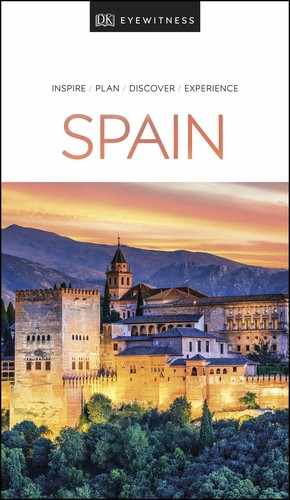Experience More
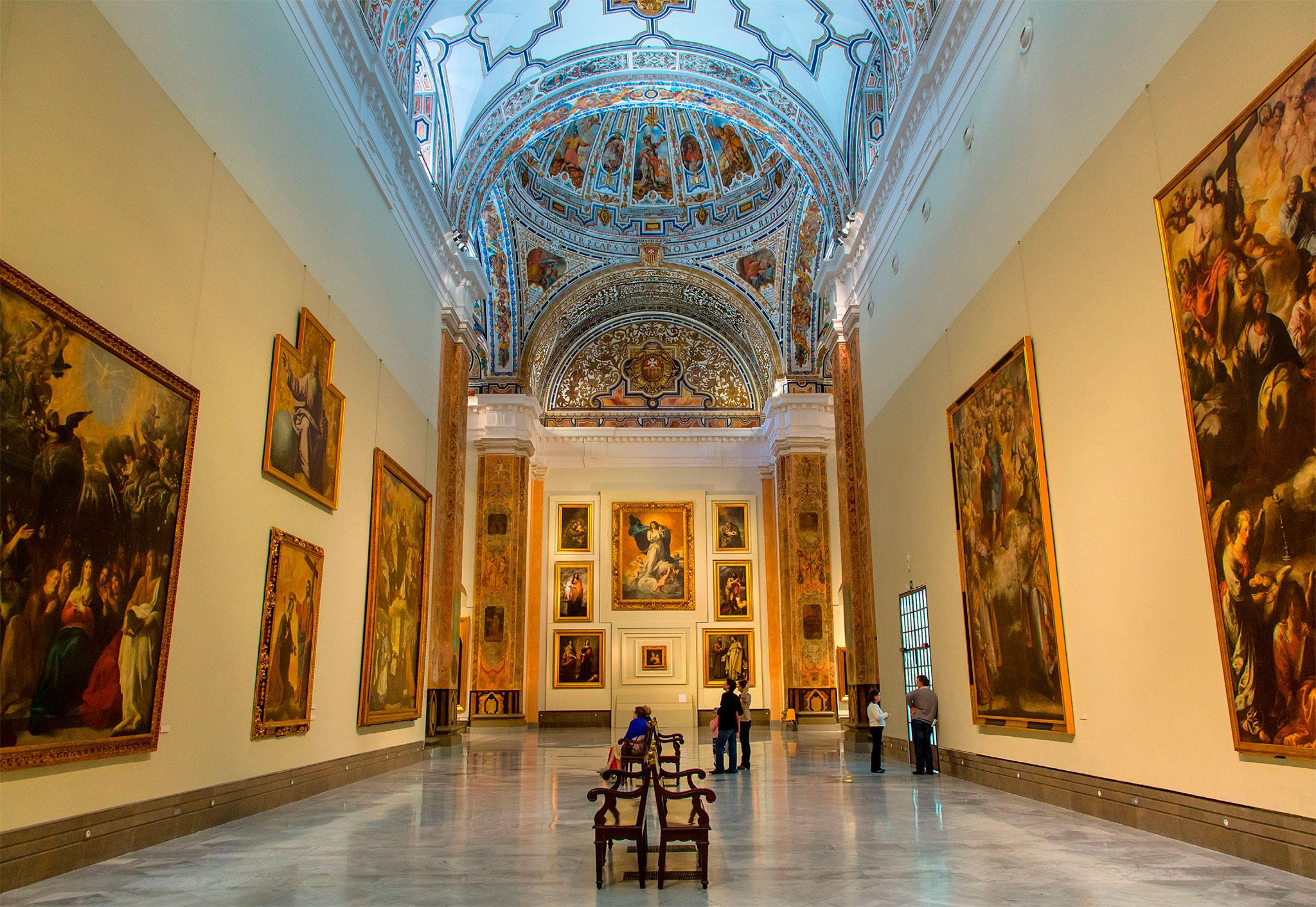
t The Museo de Bellas Artes
The Convento de la Merced Calzada houses one of the best fine art museums in Spain. Completed in 1612 by Juan de Oviedo, the building is designed around three patios. The Patio Mayor is the largest of these, remodelled by the architect Leonardo de Figueroa in 1724. The convent church is noteworthy for its Baroque domed ceiling, painted by Domingo Martínez.
The museum’s collection of Spanish art and sculpture, which spans from the medieval to the modern, focuses on the work of Seville School artists. Among the star attractions is Murillo’s La Servilleta, a Virgin and Child (1665–8), which is said to be painted on a napkin (servilleta). It now hangs in the restored convent church. The boisterous La Inmaculada (1672) by Juan de Valdés Leal is in a gallery devoted to the artist’s forceful religious paintings. Several fine works by Zurbarán include San Hugo en el Refectorio (1655), which was painted for the monastery at La Cartuja.
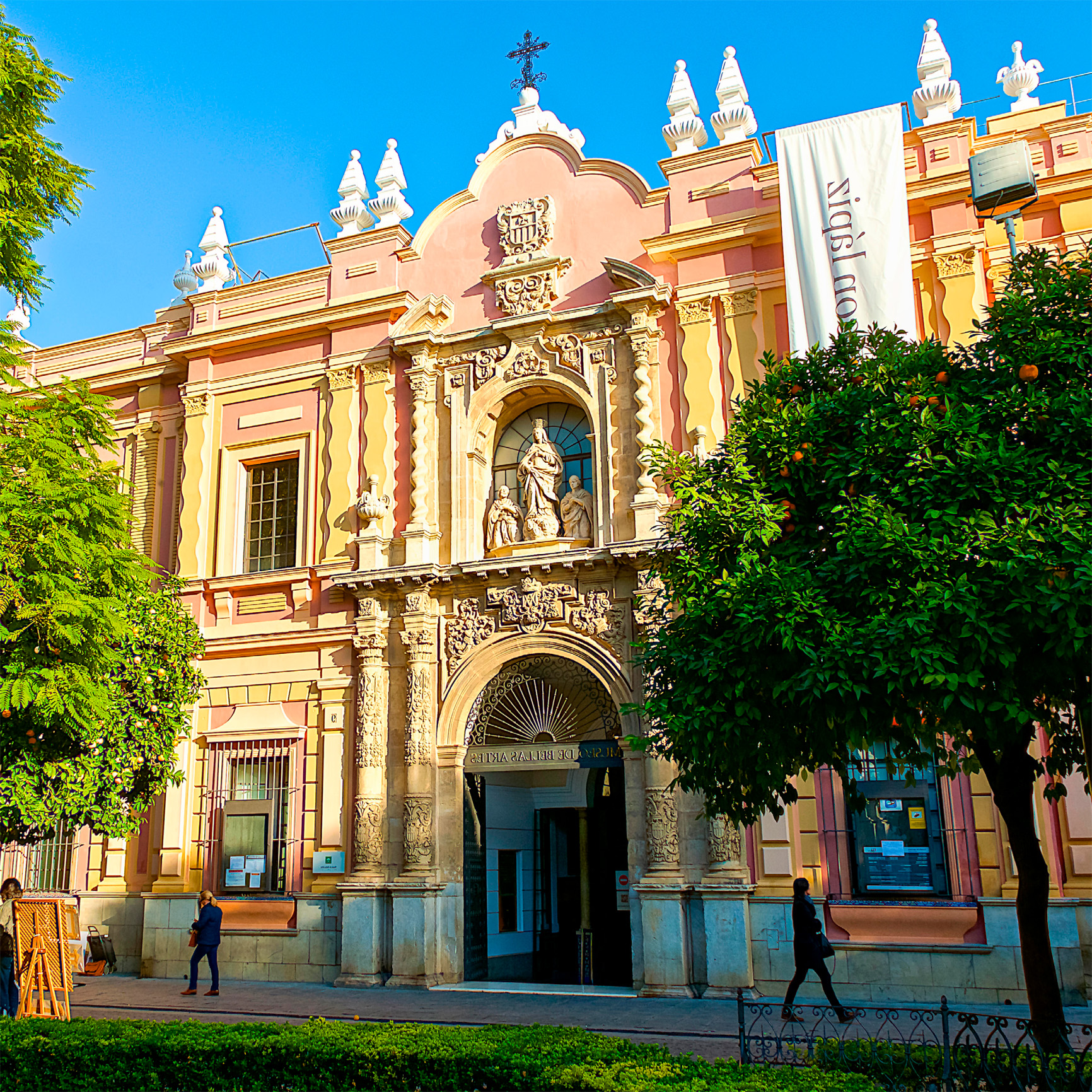
t An airy gallery
Completed in 1709, this immense Baroque church by Leonardo de Figueroa is gradually being restored to its former glory. In its southwest corner stands the Capilla de la Quinta Angustia, a Mudéjar chapel with three cupolas. This chapel survived from an earlier church where the great Seville School painter Bartolomé Murillo, the creator of La Servilleta, was baptized in 1618. The font that was used for his baptism is now in the baptistry of the present building. The church’s west front is topped by a belfry, which is painted in vivid colours.
Among the religious works in the church are a painting by Francisco de Zurbarán, St Dominic in Soria, housed in the Capilla Sacramental (to the right of the south door), and frescoes by Lucas Valdés over the sanctuary. On the wall of the north transept there is a cautionary fresco of a medieval auto-da-fé.
Seville’s famous bullring was built between 1761 and 1881 and holds up to 14,000 spectators. Whatever your opinion is of bullfighting, this immense building is interesting. Guided tours start from the entrance on Paseo de Cristóbal Colón. On the west side is the Puerta del Príncipe (Prince’s Gate), through which the triumphant matadors are carried aloft by admirers from the crowd.
Just beyond the enfermería (emergency hospital) is a museum of portraits, posters and costumes, including a purple cape painted by Pablo Picasso. The tour continues on to the chapel where matadors pray for success, and then to the stables where the horses of the picadores (lance-carrying horsemen) are kept.
This charity hospital was founded in 1674 and it is still used today as a sanctuary for elderly and infirm people. In the gardens stands a statue of its benefactor, Miguel de Mañara, whose dissolute life before he joined a brotherhood is said to have inspired the story of Don Juan.
The hospital centres around two square patios decorated with plants, 18th-century Dutch tiles, and fountains with Italian statues of Charity and Mercy. At their northern end, a passage to the right leads to another patio, containing a 13th- century arch which survives from the city’s shipyards.
The façade of the hospital church, with its whitewashed walls, reddish stonework and framed azulejos, provides a glorious example of Sevillian Baroque. Inside the church there are a number of original canvases. Directly above the entrance is the ghoulish Finis Gloriae Mundi (The End of the World’s Glory) by Juan de Valdés Leal, and opposite hangs his morbid In Ictu Oculi (In the Blink of an Eye).

t Torre del Oro at dusk, standing beside the River Guadalquivir
In Moorish Seville, the Tower of Gold formed part of the walled defences, linking up with the Real Alcázar. It was built in 1220, with a companion tower on the opposite bank. A metal chain stretched between them to prevent hostile ships from sailing upriver. The gold in its name may be the gilded azulejos that once clad its walls, or treasures from the Americas unloaded here, or the gold reflection it casts on the water. The tower has had many uses, such as a chapel and a prison, but it is now the Museo Marítimo.
EXPERIENCE Seville
|
Eat Casa Robles Enjoy the cathedral views from the terrace of this prize-winning eating spot. E4 ⌂ Calle Álvarez Quintero 58 ∑ casarobles.es ¡¡¡ Casa Plácido This tapas bar is bedecked with traditional tiles, posters and hanging hams. E4 ⌂ Calle del Mesón del Moro 5 ∑ casaplacido.es ¡¡¡ |

t Window-shopping on Calle de las Sierpes, the main shopping street
The city’s main shopping promenade, the “Street of the Snakes”, runs north from Plaza de San Francisco. Long-established stores selling hats, fans and traditional mantillas (lace headdresses) stand alongside clothes and souvenir shops. The parallel streets of Cuna and Tetuán also offer some enjoyable window-shopping.
At the southern end of Calle de las Sierpes, on the wall of the Banco Central Hispano, a plaque marks the site of the Cárcel Real (Royal Prison), where the famous Spanish writer Miguel de Cervantes (1547–1616) was incarcerated. Halfway up the road walking north, Calle Jovellanos to the left leads to the 17th-century Capillita de San José. Continuing north from here, at the junction with Calle Pedro Caravaca, you can take a look back into the anachronistic, upholstered world of the Real Círculo de Labradores, a private men’s club founded in 1856.
Right at the end of the street is La Campana, Seville’s best-known pastelería (cake shop).
Seville’s City Hall stands between the Plaza de San Francisco, where autos-da-fé (public trials of heretics) were held, and the Plaza Nueva.
Building was completed between 1527 and 1534. The side bordering the Plaza de San Francisco is a fine example of ornate Plateresque style favoured by the architect Diego de Riaño. The west front is Neo-Classical, built in 1891. Sculpted ceilings survive in the vestibule and the lower Casa Consistorial (Council Meeting Room), containing Velázquez’s Imposition of the Chasuble on St Ildefonso. The upper Casa Consistorial has a dazzling coffered ceiling and paintings by Zurbarán and Valdés Leal.

Insider Tip
Go Flamenco
Take a class at the Museo del Baile Flamenco (www.museodelbaileflamenco.com). The museum occupies a restored 18th-century house on a small street between the Plaza del Alfalfa and the cathedral and intends to give visitors an introduction to the art form. As well as the flamenco school, you can check out the exhibits and watch live performances.
EXPERIENCE Seville
Flamenco, the Soul of Andalucía
More than just a dance, flamenco is a rousing artistic expression of the joys and sorrows of life. There is no strict choreography – dancers improvise from basic movements. Although there are interpretations all over Spain, it is a uniquely Andalucían art form. Head to one of Seville’s tablaos to experience it.
The Bailaora and the BailAor

t A bailaora, wearing a traditional red dress and holding a fan
The bailaora (female dancer) is renowned for amazing footwork as well as intensive dance moments. Eva Yerbabuena and Sara Baras are both famous for their personal styles. Both lead their own acclaimed flamenco companies. Another flamenco star is Juana Amaya. The bailaor (male dancer) plays a less important role than the bailaora. However, many have achieved fame, including Antonio Canales. He has introduced a new beat through his original foot movements.
The Music and rhythm
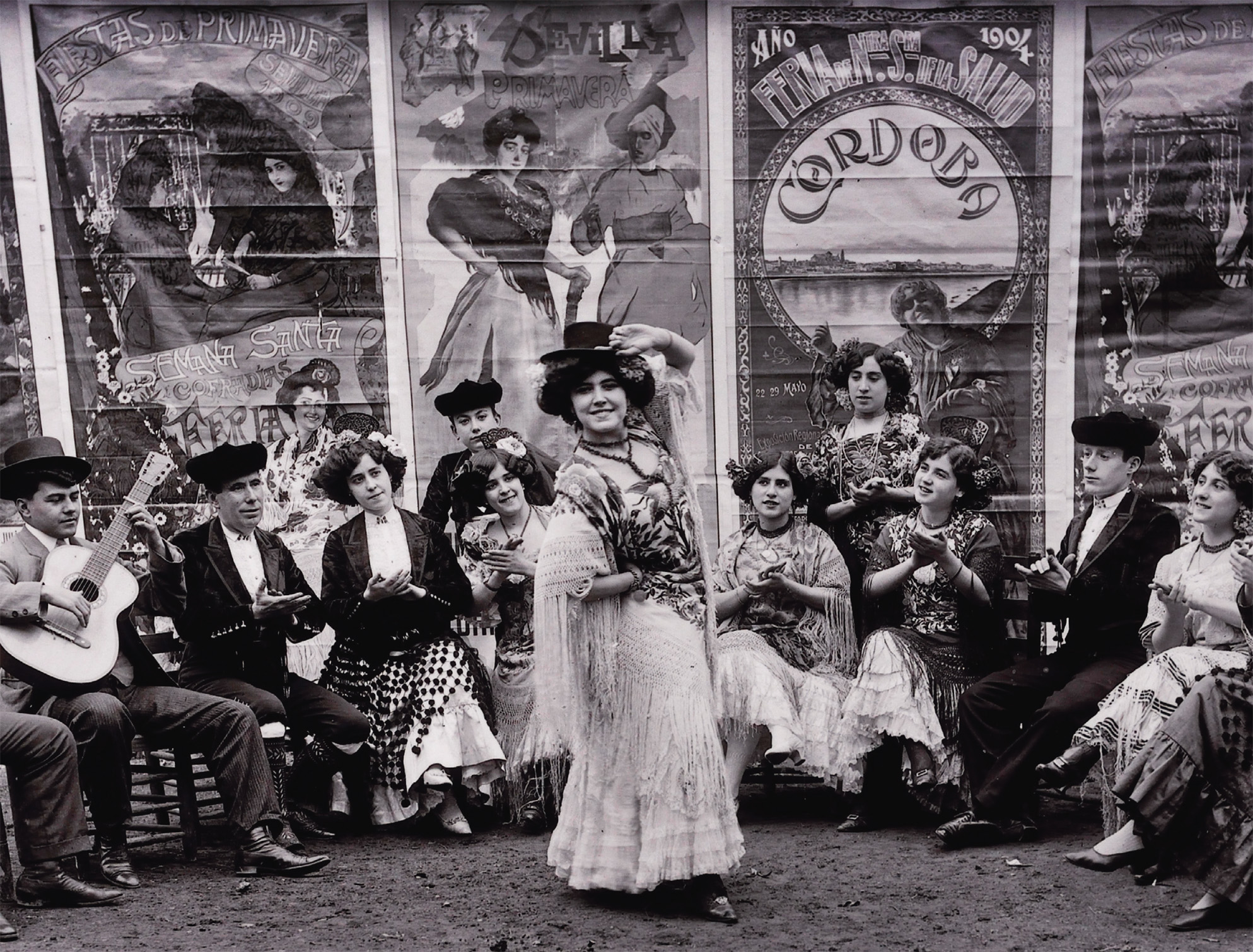
t A troupe of dancers and musicians performing flamenco in the early 20th century
Although the dancer often steals the show, it is through the music that they feel the duende (“magic spirit”). The guitar has a major role in flamenco, traditionally accompanying the singer. Flamenco guitars have a lighter, shallower construction than the modern classical guitar and a thickened plate below the sound hole, used to tap rhythms. Although the unmistakable rhythm of flamenco is created by the guitar, the beat created by hand-clapping and by the dancer’s feet in heeled shoes is just as important. The bailaoras may also beat a rhythm with castanets. Graceful hand movements, accompanying the castanets, are used to express the dancer’s feelings of the moment – whether pain, sorrow or happiness.
EXPERIENCE Seville

Seville Tablaos
La Carbonería
Catch a performance in this covered courtyard (Calle de los Céspedes 21; 95 422 99 45).
Casa de la Memoria
A small theatre set in a gorgeous patio, with performances most nights (www.casadelamemoria.es).
Los Gallos
A little more formal, but authentic nonetheless (www.tablaolosgallos.com).

t The ornately decorated church of the Hospital de los Venerables
Set in the heart of the Barrio de Santa Cruz, this home for elderly priests was begun in 1675 and completed around 20 years later by Leonardo de Figueroa. It has now been restored as a cultural centre by FOCUS (Fundación Fondo de Cultura de Sevilla).
Stairs from the delightful central, rose-coloured sunken patio lead to the upper floors, which, along with the infirmary and cellar, are used as exhibition galleries.
The Hospital church, which is a showcase of Baroque splendours, has frescoes by both Juan de Valdés Leal and his son Lucas Valdés. Other highlights of the church include sculptures of St Peter and St Ferdinand by Pedro Roldán, flanking the east door; and The Apotheosis of St Ferdinand by Lucas Valdés, top centre in the reredos of the main altar. Its frieze (inscribed in Greek) advises to “Fear God and Honour the Priest”. The sacristy’s ceiling has an effective trompe l’oeil depicting The Triumph of the Cross by Juan de Valdés Leal.
The Archive of the Indies illustrates Seville’s role in the colonization and exploitation of the New World. Built between 1584 and 1598 to designs by Juan de Herrera, co-architect of El Escorial, it was originally a lonja (exchange), where merchants traded. In 1785, Carlos III had all Spanish documents relating to the “Indies” collected under one roof. Among the archive’s 86 million handwritten pages are letters from Columbus, Cortés and Cervantes.
Upstairs, the library rooms contain displays of drawings, maps and facsimile documents.

Hidden Gem
Uncovered City
In Calle Santo Tomás, off the southeastern corner of the Plaza del Triunfo, is a building used by the Archivo de Indias. Dating from 1770, it was once a barn where tithes collected by the Church were stored. Parts of the Moorish city walls were found during the renovation of the building.
The home of the family of the Countess Lebrija since 1901, this mansion illustrates palatial life in Seville. The ground floor houses Roman and medieval exhibits, while the first floor (visited by guided tour) features a library and halls lined with Moorish-inspired azulejos. The house itself dates from the 15th century and has some Mudéjar features, including the arches around the main patio. Many of its Roman treasures were taken from the ruins at Itálica, including the mosaic floor in the main patio. The geometric ceiling above the staircase came from the palace of the Dukes of Arcos in Marchena, near Seville.
Ancient roman glassware, coins and later examples of marble from Medina Azahara are displayed in rooms off the main patio.
Enraptured by the architectural and decorative wonders of High Renaissance Italy and the Holy Land, the first Marquis of Tarifa built the Casa de Pilatos. So called because it was thought to resemble Pontius Pilate’s home in Jerusalem, today it is the residence of the Dukes of Medinaceli and is one of the finest palaces in Seville.
Visitors enter through a marble portal, commissioned by the Marquis in 1529 from Genoese craftsmen. Across the arcaded Apeadero (carriage yard) is the Patio Principal. This courtyard is essentially Mudéjar in style and decorated with azulejos and intricate plasterwork. In its corners are Roman statues, depicting Minerva, a dancing muse and Ceres, and a Greek statue of Athena, dating from the 5th century.
In its centre is a fountain that was imported from Genoa. To the right, through the Salón del Pretorio with its coffered ceiling and marquetry, is the Corredor de Zaquizamí. The antiquities on display in adjacent rooms include a bas-relief of Leda and the Swan and two Roman reliefs commemorating the Battle of Actium of 31 BC.
Coming back to the Patio Principal, you turn right into the Salón de Descanso de los Jueces. Beyond is a rib-vaulted Gothic chapel, with Mudéjar plasterwork walls and ceiling. On the altar is a copy of a 4th-century sculpture in the Vatican, The Good Shepherd. Left, through the Gabinete de Pilatos, with its small central fountain, is the Jardín Grande.
Returning once more to the main patio, behind the statue of Ceres, a tiled staircase leads to the upper floor. It is roofed with a wonderful media naranja (half-orange) cupola built in 1537. There are Mudéjar ceilings in some rooms, which are full of family portraits and antiques.

t Genoese fountain in the Patio Principal of Casa de Pilatos
EXPERIENCE Seville
|
Stay Las Casas del Rey de Baeza Chic hotel set around a courtyard, with a rooftop pool. F3 ⌂ Plaza Jesús de la Redención 2 ∑ hospes.com ¡¡¡ Patio de la Alameda This delightful B&B is stylishly furnished. E1 ⌂ Alameda de Hercules 56 ∑ patiodelaalameda.com ¡¡¡ |
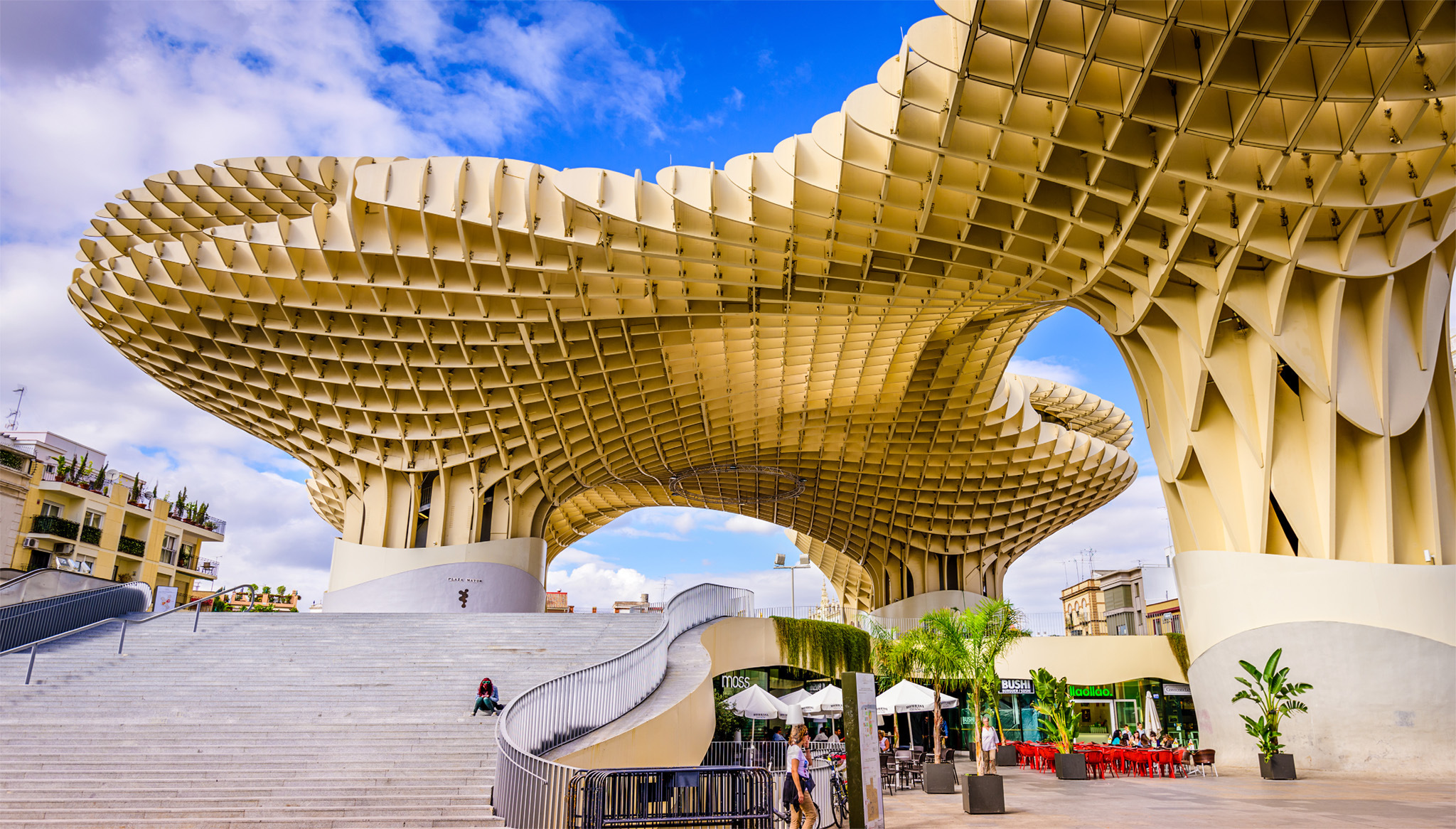
t The undulating form of the Metropol Parasol, shading the cafés and shops below
Known locally as “Las Setas” (“The Mushrooms”), this ultramodern structure with a latticed canopy was built from 2005 to 2011, and includes a museum, market, bars and restaurants. The main draw is the observation deck.

Great View
Fun Guy
Although striking from the ground, the Metropol Parasol offers the best view from its observation deck. Grab a drink from the bar and look out over the modern, wavy roof onto the historic city, counting the bell towers below.
Built in 1949 by Gómez Millán, the Basílica de la Macarena is Neo-Baroque in style and was intended as a new home for the much-loved Virgen de la Esperanza Macarena. It backs onto the 13th-century Iglesia de San Gil, where the image was housed until a fire in 1936.
The image of the Virgin, standing above the main altar amid waterfalls of gold and silver, has been attributed to Luisa Roldán (1656–1703), the most talented female artist of the Seville School. The Virgin’s magnificent processional gowns and jewels are in the Treasury museum.
This church features a mix of architectural styles; Mudéjar elements survive in the lobed brickwork of its tower, which is surmounted by a Baroque belfry. The vault of one of its chapels is decorated with exquisite geometric patterns of bricks.
Behind the Iglesia de San Pedro, at Calle Doña María Coronel 5, cakes are sold from a revolving drum in the wall of the 14th-century Convento de Santa Inés.
Built in Renaissance style with Mudéjar and Gothic influences, this 15th-century palace is the official Seville residence of the Dukes of Alba. Its courtyards offer a peaceful oasis from the bustle of the streets. The house’s grand rooms are filled with elegant period furniture, but family photos and personal letters are also scattered about, plus a room is dedicated to the history of the Feria de Abril.
Founded in 1475, Santa Paula is a working convent and home to about 30 nuns. The museum consists of two galleries filled with religious artifacts and paintings. The nave of the convent church has an elaborate wooden roof, dating from 1623. Among the statues in the church are St John the Evangelist and St John the Baptist, both the work of Juan Martínez Montañés.
This imposing palace was built in 1682 as a university to train ships’ pilots, navigators and high-ranking officers. In 1849 it became the residence of the Dukes of Monpensier and until 1893 its grounds included what is now Parque María Luisa. Today it is the presidential headquarters of the Junta de Andalucía (the regional government).
The most striking feature of the Palacio de San Telmo is the Churrigueresque portal by Leonardo de Figueroa, completed in 1734. Surrounding the Ionic columns are allegorical figures representing the Sciences and Arts.
Opposite is Seville’s most famous hotel, the Alfonso XIII, dating from the 1920s. Non-residents are welcome to visit the bar and the restaurant.
EXPERIENCE Seville

Seville Fiestas
Holy Week
Over 100 gilded pasos (floats bearing religious images) are borne through the streets between Palm Sunday and Easter Day.
Feria de Abril
Two weeks after Easter, various groups meet in casetas (entertainment booths) to drink and dance to the rhythm of Sevillanas. Riders on horseback and mantilla-crowned women in carriages parade their flamenco attire.
Corpus Christi
The Seises, boys dressed in Baroque costume, dance before the main altar of the cathedral on this day in May or June.
The former Real Fábrica de Tabacos (Royal Tobacco Factory) is now part of Seville University. In the 19th century, three-quarters of Europe’s cigars were manufactured in this building, rolled by 10,000 cigarreras (female cigar-makers). These women were the inspiration for French author Mérimée’s Carmen.
Built in 1728–71, the factory complex is the third-largest building in Spain. The moat and watchtowers are evidence of the importance given to protecting the king’s lucrative tobacco monopoly.

t A monument paying tribute to flamenco at the centre of the Triana quarter
This close-knit area, named after the Roman Emperor Trajan, was once Seville’s Romani quarter. Triana remains a traditional working-class district, with compact, flower-filled streets. For centuries it has been famous for its potteries and associations with flamenco. Worth a visit is the museum dedicated to this fine craft at Centro Cerámica Triana (Calle Callao 16), formerly the factory of the Cerámica Santa Ana shop. Among other displays, you can admire tiles decorated by the famous Aníbal González, before seeing the kilns used in production (some dating from the 16th century), plus tools and materials.
A good way to approach Triana is across the Puente de Isabel II, leading to the Plaza del Altozano. The Museo de la Inquisición, in Castillo de San Jorge, is largely tasteful and avoids sensational images, concluding with a presentation on human rights today.
Nearby is one of the characteristic streets of the area, the Calle Rodrigo de Triana, named after the Andalucían sailor who was the first to sight the shores of the New World on Columbus’s voyage of 1492.
The Iglesia de Santa Ana, founded in the 13th century, is Triana’s most popular church. In the baptistry is the famous font, believed to pass on the gift of flamenco song to the children of the faithful.

Hidden Gem
O-Wow
Located in the heart of Triana, the 17th-century Iglesia de Nuestra Señora de la O is easily spotted by its colourful tiled belfry. Step inside to see more beautiful ceramics, along with some impressive Baroque sculptures.
The site of Expo ’92, this area has since been transformed into a sprawling complex of exhibition halls, museums and entertainment and leisure spaces.
The 15th-century Monasterio de Santa María de las Cuevas, inhabited by monks until 1836, now houses the Centro Andaluz de Arte Contemporáneo, which contains works by Andalucían artists, plus Spanish and international art. Free jazz jam sessions take place in the patio of the café on Sundays.
The centrepiece of Expo ‘92, the Lago de España, is part of the Isla Mágica theme park. This re-creates the journeys and exploits of the explorers who left Seville in the 16th century for the New World. Isla Mágica also has a fun-filled water park, the Agua Mágica.
"
Centro Andaluz de Arte Contemporáneo
⌂ Avenida Américo Vespucio 2 # 11am–9pm Tue–Sat, 10am–3:30pm Sun & public hols ∑ caac.es
"
Isla Mágica
⌂ Pabellón de España s/n # Hours vary, check website ¢ Nov–mid-Apr ∑ islamagica.es
Did You Know?
Seville’s motto – “no8do” – stands for “no me ha dejado” (she has not deserted me).
Designed by the Argentine architect César Pelli, this 40-storey tower was the subject of much controversy while in its planning stages. Despite UNESCO voting against its construction, due to its obstruction of the skyline, the Torre Sevilla now presides over the Guadalquivir River, offering commanding panoramic views.
Opened in 2015, it is the tallest building in Andalucía and houses a five-star hotel on the top 19 floors. The remaining floors are primarily devoted to office space.
For a good view of the tower itself, visit the adjacent shopping centre’s garden roof.
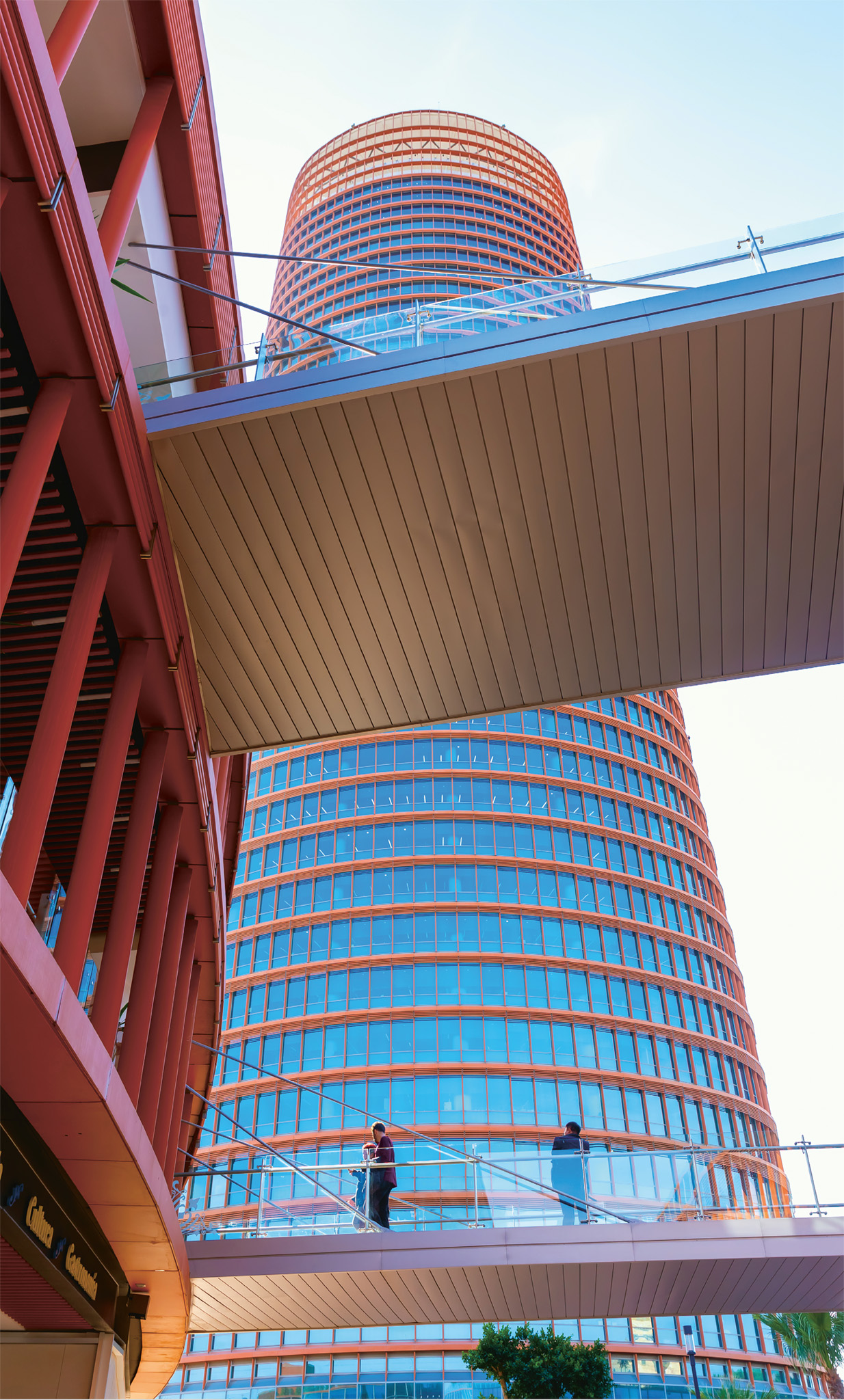
t The modern Torre Sevilla, soaring 180.5 m (591 ft) into the sky
Housed in the Tower of Perdigones, this huge camera obscura uses mirrors and magnifying lenses to display an image of the surrounding area. The top of the tower itself also offers scenic views.
EXPERIENCE Seville
|
Shop Botellas y Latas Gourmet shop overflowing with regional products such as artisan cheeses, Iberian ham, sausages, choice patés, preserves, olive oil, wine and beers. E2 ⌂ Calle Regina 14 ∑ elclubdelgourmet.es Rompemoldes A complex of workshops where artists and craftsmen work, exhibit and sell to the public. Find ceramics, jewellery, clothing, sculptures, decorative pieces and paintings. Hours vary according to each individual space. F2 ⌂ Calle San Luís 70 ∑ rompemoldes.com |
